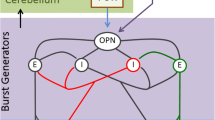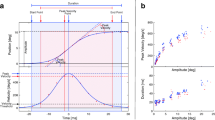Abstract
Saccadic eye movements are traditionally cited as an especially successful combination of accuracy and velocity, such high level of performances being believed to be crucial for optimal vision. Although the structures subtending these properties are now well recognized, very little is known about the functional consequences on visually guided behaviors of reduced saccade performances, i.e., slowness and/or inaccuracy. We therefore investigated the impact of such impairments in patients with spino-cerebellar and Friedreich ataxia, i.e., diseases known to affect both saccade parameters. Subjects performed a classical eye movement task, in order to quantify saccade inaccuracy and/or slowness, a visually search task and a reading task and completed a questionnaire designed to evaluate their perceived visual discomfort in daily activities. The first main result was that saccade impairments did have an impact on visually guided behaviors, resulting in an increased time for target detection, especially when accurate foveation was needed, and in an increased reading time. The main responsible oculomotor factor was increased variability of saccade accuracy, and the least responsible factor was reduced saccade velocity. The second main result was that saccade disorders did not induce significant subjective discomfort, since no correlations were found between the results of the questionnaire and saccade parameters. These results emphasize the functional impact of increased variable error of saccade accuracy and question the rationale of high saccade velocities. The discrepancy between objective and subjective measures underlines the largely unconscious aspect of saccade control and leads us to consider the need for an adapted therapy.



Similar content being viewed by others
References
Leigh RJ, Zee DS. The neurology of eye movements. New York: Oxford University Press; 2006.
Spieker S, Schulz JB, Petersen D, et al. Fixation instability and oculomotor abnormalities in Friedreich’s ataxia. J Neurol. 1995;242:517–21.
Klostermann W, Zühlke C, Heide W, et al. Slow saccades and other eye movement disorders in spinocerebellar atrophy type 1. J Neurol. 1997;244:105–11.
Buttner N, Geschwind D, Jen JC, et al. Oculomotor phenotypes in autosomal dominant ataxias. Arch Neurol. 1998;55:1353–7.
Rivaud-Pechoux S, Dürr A, Gaymard B, et al. Eye movement abnormalities correlate with genotype in autosomal dominant cerebellar ataxia type I. Ann Neurol. 1998;43:297–302.
Bürk K, Fetter M, Abele M, et al. Autosomal dominant cerebellar ataxia type I: oculomotor abnormalities in families with SCA1, SCA2, and SCA3. J Neurol. 1999;246:789–97.
Schmitz-Hübsch T, du Montcel ST, Baliko L, et al. Scale for the assessment and rating of ataxia: development of a new clinical scale. Neurology. 2006;66:1717–20.
Schulz JB, Borkert J, Wolf S, et al. Visualization, quantification and correlation of brain atrophy with clinical symptoms in spinocerebellar ataxia types 1, 3 and 6. NeuroImage. 2010;49:158–68.
Mangione CM, Lee PP, Gutierrez PR, et al. Development of the 25-item National Eye Institute Visual Function Questionnaire. Arch Ophthalmol. 2001;119:1050–8.
Nyström M, Holmqvist K. An adaptive algorithm for fixation, saccade, and glissade detection in eyetracking data. Behav Res Methods. 2010;42:188–204.
White M, Lalonde R, Botez-Marquard T. Neuropsychologic and neuropsychiatric characteristics of patients with Friedreich’s ataxia. Acta Neurol Scand. 2000;102:222–6.
Wollmann T, Nieto-Barco A, Montón-Alvarez F, et al. Friedreich’s ataxia: analysis of magnetic resonance imaging parameters and their correlates with cognitive and motor slowing. Rev Neurol. 2004;38:217–22.
Fahey MC, Cremer PD, Aw ST, et al. Vestibular, saccadic and fixation abnormalities in genetically confirmed Friedreich ataxia. Brain. 2008;131:1035–45.
Thier P, Haarmeier T, Treue S, et al. Absence of a common functional denominator of visual disturbances in cerebellar disease. Brain. 1999;122:2133–46.
Machner B, Sprenger A, Kömpf D, et al. Cerebellar infarction affects visual search. NeuroReport. 2005;16:1507–11.
Dale RT, Kirby AW, Jampel RS. Square wave jerks in Friedreich’s ataxia. Am J Ophthalmol. 1978;85:400–6.
Kirkham TH, Guitton D, Katsarkas A, et al. Oculomotor abnormalities in Friedreich’s ataxia. Can J Neurol Sci. 1979;6:167–72.
Furman JM, Perlman S, Baloh RW. Eye movements in Friedreich’s ataxia. Arch Neurol. 1983;40:343–6.
Schöls L, Linnemann C, Globas C. Electrophysiology in spinocerebellar ataxias: spread of disease and characteristic findings. Cerebellum. 2008;7:198–203.
Donato SD, Mariotti C, Taroni F. Spinocerebellar ataxia type 1. Handb Clin Neurol. 2012;103:399–421.
Quaia C, Lefèvre P, Optican LM. Model of the control of saccades by superior colliculus and cerebellum. J Neurophysiol. 1999;82:999–1018.
Averbuch-Heller L, Stahl JS, Hlavin ML, et al. Square-wave jerks induced by pallidotomy in parkinsonian patients. Neurology. 1999;52:185–8.
Salman MS, Sharpe JA, Lillakas L, et al. Visual fixation in Chiari type II malformation. J Child Neurol. 2009;24:161–5.
Velázquez-Pérez L, Seifried C, Santos-Falcón N, et al. Saccade velocity is controlled by polyglutamine size in spinocerebellar ataxia 2. Ann Neurol. 2004;56:444–7.
Rüb U, Brunt ER, Gierga K, et al. The nucleus raphe interpositus in spinocerebellar ataxia type 3 (Machado-Joseph disease). J Chem Neuroanat. 2003;25:115–27.
Geiner S, Horn AK, Wadia NH, et al. The neuroanatomical basis of slow saccades in spinocerebellar ataxia type 2 (Wadia-subtype). Prog Brain Res. 2008;171:575–81.
Quinet J, Goffart L. Head-unrestrained gaze shifts after muscimol injection in the caudal fastigial nucleus of the monkey. J Neurophysiol. 2007;98:3269–83.
Von Noorden GK, Mackensen G. Phenomenology of eccentric fixation. Am J Ophthalmol. 1962;53:642–60.
Pélisson D, Alahyane N, Panouillères M, et al. Sensorimotor adaptation of saccadic eye movements. Neurosci Biobehav Rev. 2010;34:1103–20.
Desmurget M, Pélisson D, Urquizar C, et al. Functional anatomy of saccadic adaptation in humans. Nat Neurosci. 1998;1:524–8.
Suzuki Y, Kase M, Hashimoto M, et al. Leaky neural integration observed in square-wave jerks. Jpn J Ophthalmol. 2003;47:535–6.
Kawai Y, Suenaga M, Watanabe H, et al. Cognitive impairment in spinocerebellar degeneration. Eur Neurol. 2009;61:257–68.
Nieto A, Correia R, de Nobrega E, Monton F, Hess S, Barroso J. Cognition in Freidreich ataxia. Cerebellum 2012;11:834–44.
Rayner K, Slattery TJ, Bélanger NN. Eye movements, the perceptual span, and reading speed. Psychon Bull Rev. 2010;17:834–9.
Clausi S, De Luca M, Chiricozzi FR, Tedesco AM, Casali C, Molinari M, Leggio MG. Oculomotor deficits affect neuropsychological performance in oculomotor apraxia type 2. Cortex 2012 [Epub ahead of print]
Hyönä J, Bertram R, Pollatsek A. Are long compound words identified serially via their constituents? Evidence from an eye-movement-contingent display change study. Mem Cognit. 2004;32:523–32.
McAskill MR, Anderson TJ, Jones RD. Suppression of displacement in severely slowed saccades. Vision Res. 2000;40:3405–13.
Grunfeld EA, Shallo-Hoffmann JA, Cassidy L, et al. Vestibular perception in patients with acquired ophthalmoplegia. Neurology. 2003;60:1993–5.
McLaughlin SC. Parametric adjustment in saccadic eye movements. Perception and Psychophysics. 1967;2:359–62.
Guerraz M, Yardley L, Bertholon P, et al. Visual vertigo: symptom assessment, spatial orientation and postural control. Brain. 2001;124:1646–56.
Conflict of Interest
The authors declare no conflict of interest.
Author information
Authors and Affiliations
Corresponding author
Additional information
Alexandre MF: Deceased July 17, 2012
Electronic supplementary material
Below is the link to the electronic supplementary material.
ESM 1
(DOCX 31 kb)
Rights and permissions
About this article
Cite this article
Alexandre, M.F., Rivaud-Péchoux, S., Challe, G. et al. Functional Consequences of Oculomotor Disorders in Hereditary Cerebellar Ataxias. Cerebellum 12, 396–405 (2013). https://doi.org/10.1007/s12311-012-0433-z
Published:
Issue Date:
DOI: https://doi.org/10.1007/s12311-012-0433-z




